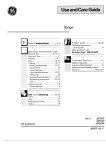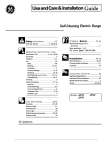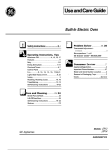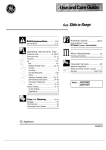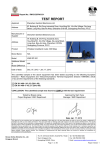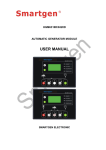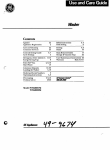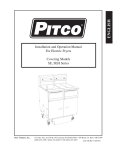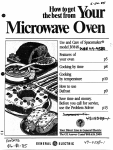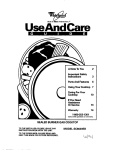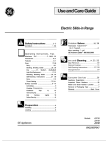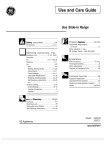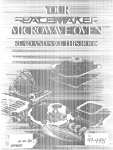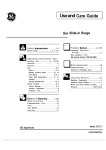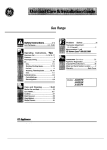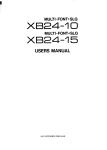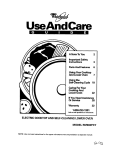Download GE JGSP20 P User's Manual
Transcript
—
GmS!#ide-ih Range
Contents
Aluminum Foil
Anti-Tip Device
Appliance Registration
Care and Cleaning
2
16-23
Clock
Consumer Services
10
31
Electronic Controls
Features
10
6,7
Flooring Under the Range
Leveling
—
12
3,6,28
Lift-Up Cooktop
Minute/Second Timer
Model and Serial Numbers
Oven
Air Adjustment
Baking, Baking Guide
5
5
16
10
2
9
24
12, 13
Broiler Pan and Rack 15, 19,23
Broiling, Broiling Guide
15
Control Settings
Door Removal
Light; Bulb Replacement
Oven Bottom Removal
Oven Timer
Preheating
ModeIsJGSP20GEP
JGSP21GEP
—
GEAppBances
Roasting, Roasting Guide 14
Self-Cleaning Instructions 20-22
Shelves
Thermostat
Adjustment
Safety Instructions
Surface Cookinz
2-5
8,9
18
17
Burner Grates
Burners
Control Settings
Cookware Tim
8
9
18
8
Drip Pans
Flame Size
Lighting Instructions
Toe Space Filler
10, 11
18
9, 19
24
10,11
13
10
26
Vent Duct
Problem Solver
Warranty
GEAnswer Cent@
800.6262008
9, 19
25
8
27
Back Cover
Help us help you...
Read this book carefully.
It is intended to help you operate
and maintain your new oven
properly.
Keep it handy for answers to your
questions.
If you don’t understand something
or need more help, write (include
your phone number):
Consumer Affairs
GE Appliances
Appliance Park
Louisville. KY 40225
Write down the model and
serial numbers.
You’ll find them on a label located
on the front frame behind the
storage drawer front. See pages 6
and 7.
These numbers are also on the
Consumer Product Ownership
Registration Card that came with
your range. Before sending in this
card, please write these numbers
here:
Model Number
Serial Number
Use these numbers in any
correspondence or service calls
concerning your oven.
If you received
a damaged range...
Immediately contact the dealer (or
builder) that sold you the range.
Save time and money.
Before you request
service...
Check the Problem Solver on page
26. It lists causes of minor
operating problems that you can
correct yourself.
If you need service...
To obtain service, see the
Consumer Services page in the
back of this book.
We’re proud of our service and
want you to be pleased. If for some
reason you are not happy with the
service you receive, here are three
steps to follow for further help.
FIRST, contact the people who
serviced your appliance. Explain
why you are not pleased. In most
cases, this will solve the problem.
NEXT, if you are still not pleased,
write all the details—including
your phone number—to:
Manager, Consumer Relations
GE Appliances
Appliance Park
Louisville, KY 40225
FINALLY, if your problem is still
not resolved, write:
Major Appliance Consumer
Action Panel
20 North Wacker Drive
Chicago, IL 60606
IL
WARNING: If the
information in this
manual is not followed ‘
exactly, a fire or explosion
may result causing
property damage,
personal injury or death.
— Do not store or use
gasoline or other
flammable vapors and
liquids in the vicinity of
this or any other
appliance.
— WHAT TO DO IF YOU
SMELL GAS
● Do not try to light any
appliance.
● Do not touch any
electrical switch; do not
use any phone in your
building.
● Immediately call your
—
gas supplier from a
neighbor% phone.
Follow the gas supplier’s
instructions.
● If you cannot reach your
gas supplier, call the fire
department.
— Installation and service
must be performed by a
qualified installer, service
agency or the gas supplier.
.—
2
—
—
IMPORTANT SAFETY INSTRUCTIONS (continu~d)
Read all instructions before using this appkwe.
* ~ ~@~ stare fl~~#Jl@
AMiip turn surface burner
●
materials in the oven or the
to OFF before removing
Cookihp,
cookware.
(kef~li~ watch foods being
* Do not ~~e or ~~
fried at a high flame setting,
combustible materials, gasoline
s N~r b~~ek $h~ ve~~ (~r
opetigs) of the range. They
provide the air iniet and outlet
that are necessary for the range
tu operate properly with correct
combustion+ Air operiings are
kmted at the rem of the COOktUp,
at the top cfthe oven door and
under the storage drawer.
@ Do ~~$ use a wok on the
storage drawer or near the
●
or other flmmmb}e vapors and
Equids in the vicinity @ft.his or
any other appliance,
*Do not let Hx&ing gor other flammable nrateriais
acmmdate in or mar the rauge,
s %$%e~ coddng Porky fOiiOW
the directions oxactiy and always
cook the meat to an interred
temperature of at least 170°F.
‘l’his assures tha$ in the remote
possibility that trichinarmy be
present in the meat, it will be
kiikxl and meat wiil be safk to eat
Shmfttce
Cocking
* Always use the LITE poskkm
when igniting top burners and
N~e~ leave s~rfa~e bum~~
umttmded at high flame
●
emking surface if the wok has a
as a heat trap which may damage
the burnergmte and burner head.
Also, it may cause the burner to
work improperly. This may cause
a carbon monoxide level abcwe
that Wowed by current standards,
resuhi~g in a heaith hazard.
settings. Boilmwr causes
srnuking and greasy spillovtms
that may catch on fire,
S ~jwt top burner fhtmt? ~i~
foods orrnoii%urton fresh foods
can cause hot M to bubble up End
over sides of pan.
does not extend beyond the
edge of the cookware. Excessive
flame is hazardous.
. use W@ dry pot ha14ers—
use least possible ammmt of
fat for effective shallow or deepfat frying. Filling thepantoo full
moist or damp potholders on hot
surfaces may result in burns from
steam. Do not let pot holders come
near open flames when lifting
cookware. Do not use a towel or
other bulky cloth in place of a pot
holder.
o ~ minimize the possibility
of bums, ignition affiammable
materials, and spillage, turn the
cookware handles toward the side
or back of the range without
extending over adjacent burners.
tipped. Seleet COOkwam having flat
bottoms large enough to properly
contain food avoiding boiIovers
and spi.llowxs, and l~rge enough
to eoverburner grate. This will
both save cleaning and prevent
hazardous tm.mmlations of food,
since heavy spattering or spilknwrs
left on range can ignite. We pans
with handIes that can be easily
grasped and remain cool.
o When using glkss cookware?
make sure it is designed for top-ofrange cooking.
* iQep ail plastics away from
top burners.
rmmd metal ring which is
piaceii over the burner grate to
support thfi wok. This ring acts
s p-far frying should be *
dry as possible. Frost on frozen
so it
—
●
of fat can cause spillmwrs when
fbod is added.
If a c~mbi~atjo~ of ~il~ or
fats wiil beumd in f@ng, stir
●
together b~fore heating or as fats
melt slowly.
m AIWayS heat fa$ Slowly$ and
watch as it heats.
. u= deep fat thermometer
whenever possible to prevent
overheating fat beyond the
smoking point.
* Use proper pan size-Avoid
pans that are unstable or easily
—
e ~0 nut leave plastic items on
themoktop-they may melt if
left too close to the vent.
Q Do Mot leav~ any items on the
co#ktop. The hot air from the
vent may ignite flammabIe items
and will increase pressure in
closed containers, which may
cause them to burst.
s TO avoid $he possibility @f&
burn, always be certai~ that the
controls for ali burners are at
OFF position and all grates am
cool before attempti~g to
remove them.
o When ilaming foods are
under the hood, turn the fan
off. The fan, if operating9 may
spread the flames.
e Iframge is located near a
wi~dow, do not use long curtains
that could blow over the top
burners and create a fire hazard. -
—
If you smell gas, turn off the
gas to the range and call a
qualified service technician.
Never use an open flame to
locate a leak.
●
Baking, Broiling and
Roasting
Do not use oven for a storage
area. Items stored in the owm
can ignite.
Stand away from the range
when opening the door of a hot
oven. The hot air or steam that
escapes can cause burns to
hands, face and eyes.
Place oven shelves in desired
position while oven is cool.
Pulling out the shelf to the
shelf stop is a convenience in
lifting heavy foods. It is also a
precaution against burns from
touching hot surfaces of the
door or oven walls.
Don$t heat unopened food
containers in the oven. Pressure
could bui~d up and the
container could burst causing
an injury.
Don% use aluminum foil
anywhere in the oven except as
described in this book. Misuse
●
●
●
●
●
●
could result in afire hazard or
darnage to the range.
o When using cooking or
roasting bags in the oven, follow
the manufacturer’s directions.
Use only glass cookware that is
recommended for use in gas ovens.
●
* Keep the oven free from
grease buildup.
* Always remove the broiler
pan from the oven as soon as
you finish broiling. Grease left
—
in the pan cart catch fire if oven is
used without removing the grease
from the broiler pan.
●
Make sure the broiler pan
and rack are in piace correctly
to reduce the possibility of a
grease fire.
@ When broiling, if meat is too
close to the flames, the fat may
ignite. Trim excess fat to prevent
excessive flare-ups.
If you shodd have a grease
fire in the broiler pan, turn off
●
oven, and keep oven door closed
to contain fire until it burns out.
Cleaning Your Range
Clean only parts listed in this
Use and Care Book.
Keep range clean and free of
accumulations of grease or
spillovers, which may ignite.
Self-Cleaning Oven
Do not clean the door gasket
before reading special cleaning
instructions on page 20. The
●
●
●
door gasket is essential for a
good sd. Be catwful not to rub,
damage or move it.
●
Do not use oven cleaners. No
commercial oven cleaner or oven
liner protective coating of any
kind should be used in or around
any part of the oven,
o Before self-cleaning the oven?
remove broiler pan and other
cookware.
Don’t attempt to repair or
replace any part of your range
unless it is specifically
recommended in this book. All
●
other servicing should be referred
to a qualified technician.
Be sure to wipe up excess
spillage before starting the
self-cleaning operation.
Listen for fan-a fan noise
●
●
should be heard sometime during
the cleaning cycle. If not, call for
service before self-cleaning again.
Flooring Under
the Range
Your range, like so many other
household items, is heavy and
can settle into soft floor
coverings such as cushioned
vinyl or carpeting. When moving
the range on this type of flooring,
use care, and it is recommended
that these simple and inexpensive
instructions be followed.
The range should be installed on a
l/4-inch-thick sheet of plywood
(or similar material) as follows:
When the floor covering ends at
the front of the range, the area
that the range will rest on should
be built up with plywood to the
same level or higher than the floor
covering. This will allow the range
to be moved for cleaning or
servicing.
Leveling the Range
Use a 1%” open-end or adjustable
wrench to equally back out the
four legs. The flanges (rims) below
the sides of the maintop must be
raised above the top of the
countertop. Carefully slide the
range into its installation space.
Observe that it is clearing the
countertop. Then place a spirit
level or a glass measuring cup
partially filled with water on one
of the oven shelves to check for
levelness. If using a spirit level,
take two readings, with the level
placed diagonally first in one
direction and then the other.
Adjust the four legs carefully.
Level the range front to back and
side to side. The range legs must
rest on the floor. The range must
not hang from the countertop.
If the self-cleaning mode
malfunctions, turn off and
disconnect power supply. Have
●
serviced by a qualified
technician.
SAVE THESE
INSTRUCTIONS
5
Features of Your Range
—
Mode] JGsP20GEp with Brushed Chrome Cooktop show
n
6
—
Feature Index
1 Model and Serial Numbers
(in burner boxundercooktop)
2
2 Anti-Tip Device
(see Installation Instructions)
3,5,28
3 Oven Door Gasket
20
4 Removable Oven Bottom
24
5 Oven Shelves
(easily removed orrepositionedon shelf supports)
.
Explained
on page
9,19
6 Surface Burner Controls
8
7 Lift-Up CooMop
(JGSP20GEP–Brushed Chrome, JGSP21GEP–White
Porcelain Enamel) (support rods hold it up to simplify
cleaning underneath)
16
8 Oven Vent
10
9 Surface Burners, Grates and Chrome
Drip Pans
8,17,18
10 OVEN CANCEL button
(push it to cancel any oven operation)
11
11 Electronic Display Panel
10
12 Oven “On” Indicator
9,10
13 Set Knob
(lets you set oven temperature, clock timer and
HI or LO broil)
10,11
14 Oven Light Switch
(lets you turn interior oven light on and off)
10
15 Electronic Controls
Automatic Oven Timer
(turns your oven on and off for you automatically)
Oven Control and Thermostat
Clock
Minute/Second Timer
(lets you time any kitchen function, even when
the oven is in use)
10,11
11
16 Oven Interior Light
10,19
17 Oven Shelf Supports
9
18 Removable Oven Door
(easily removed for oven cleaning)
18
19 Storage Drawer
23
20 Broiler Panand Rack
10,11
10
10
15,19
7
Surface Cooking
Electric Ignition
Your surface burners are lighted by
electric ignition, eliminating the
need for standing pilot lights with
constantly burning flames.
In case of a power failure, you
can light the surface burners on
your range with a match. Hold a
lighted match to the burner, then
turn the knob to the LITE position.
Use extreme caution when
lighting burners this way.
Surface burners in use when an
electrical power failure occurs will
continue to operate normally.
To Light a Surface Burner
Watch the flame, not the knob, as
you reduce heat.
The flame size on a gas burner
should match the cookware you
are using.
Push the control knob in and turn it
counterclockwise to LITE. You
will hear a little clicking noise—
the sound of the electric spark
igniting the burner.
Surface Burner Controls
Knobs that turn the surface burners
on and off are marked as to which
burners they control. The two
knobs on the left control the left
front and left rear burners. The two
knobs on the right, nearest to the
electronic panel, control the right
front and right rear burners.
Super Burner
Some models have a cone-shaped
cooktop burner, with a circular
opening through the center of the
burner. The right front burner is
the Super Burner. This burner can
provide 30% more power than the
other three. Use it for cooking
large amounts of food in a big pan,
canning, etc.
How to Select Flame Size -
After the burner ignites, turn the
knob to adjust the flame size.
After Lighting a Burner
● Check to be sure the burner
you turned on is the one you want
to use.
● Do not operate a burner for an
extended period of time without
cookware on the grate. The finish
on the grate may chip without
cookware to absorb the heat.
● Be sure the burners and grates are
cool before you place your hand, a
potholder, cleaning cloths or other
materiaIs on them.
FOR SAFE HANDLING OF
COOKWARE, NEVER LET THE
FLAME EXTEND UP THE
SIDES OF THE COOKWARE.
Any flame larger than the bottom
of the cookware is wasted and only
serves to heat the handle.
When using aluminum or
aluminum-clad stainless steel
pots and pans, adjust the flame so
the circle it makes is about 1/2
inch smaller than the bottom of the
cookware.
When boiling, use this same flame
size—1/2 inch smaller than the
bottom of the cookware—no
matter what the cookware is made
of. Foods cook just as quickly at a
gentle boil as they do at a furious
rolling boil. A high boil cooks
away moisture, flavor and
nutrition. Avoid it except for the
few cooking processes which need
a vigorous boil.
When frying or warming foods
in stainless steel, cast iron or
enamelware, keep the flame
down lower—to about 1/2 the
diameter of the cookware.
When frying in glass or ceramic
cookware, lower the flame even
more.
–
Using Your Oven
Top-of-Range Cookware
Aluminum: Medium-weight
cookwme is nxommended because it
heats quickly and evenly. Most fxxls
brown evenly in an aluminum skillet.
Minerals in fd and water will stain
but will not harm aluminum. A
quick scour with a soap-filled steel
wool pad after each use keeps
aluminum cookware looking shiny
and new. Use saucepans with tightfitting lids for cooking with
minimum amounts of water.
Cast Iron: If heated slowly, most
skillets will give satisfactory results.
Enamelware: Under some
conditions, the enamel of some
cookware may melt. Follow cookware
manufacturer’s recommendations
for cooking methods.
Glass: There are two types of glass
cookware-those for oven use only
and those for top-of-range cooking
(saucepans, coffee and teapots).
Glass conducts heat very slowly.
Heatproof Glass Ceramic: Can
be used for either surface or oven
cooking. It conducts heat very
slowly and cools very slowly.
Check cookware manufacturer’s
directions to be sure it can be used
on gas ranges.
Stainless Steel: This metal alone
has poor heating properties, and is
usually combined with copper,
aluminum or other metals for
improved heat distribution.
Combination metal skillets usually
work satisfactorily if they are
used with medium heat as the
manufacturer recommends.
—
Electric Ignition
The oven burner and broil
burner on your range are lighted
by electric ignition.
To light either burner, push the
button for the desired function and
turn the SET knob until the desired
temperature is displayed. The burner
should ignite within 60 seconds.
Power Outage
CAUTION: DO N~ MAKE
ANY ATTEMPT TKl
OPERATE THE ELECTRIC
IGNITION OVEN DURING
AN ELECTRICAL POWER
OUTAGE. Neither the oven
nor the broiler can be lit during
an electrical power outage. Gas
will not flow unless the glow
bar is hot.
If the oven is in use when a
power outage occurs, the oven
burner shuts off and cannot be
re-lit until power is restored.
Oven Shelves
To remove a shelf from the oven,
pull it toward you, tilt front end
upward and pull shelf out.
To replace, place shelf on shelf
support with stop-locks (curved
extension of shelf) facing up and
toward rear of oven. Tilt up front
and push shelf toward back of oven
until it goes past “stop” on oven
wall. Then lower front of shelf and
push it all the way back.
Shelf Positions
The oven has four shelf supports—
A (bottom), B, C and D (top).
Shelf positions for cooking are
suggested on Baking and Roasting
pages.
\
The shelves are designed with stoplocks so when placed correctly on
the shelf supports, they will stop
before coming completely out of
the oven and will not tilt when you
are removing food from them or
placing foo{on them.
When placing cookware on a shelf,
pull the shelf out to the “stop”
position. Place the cookware on
the shelf, then slide the shelf back
into the oven. This will eliminate
reaching into the hot oven.
Oven Light
Use the switch on the control panel
to turn the light on and off.
(continued nextpage
9
Using Your Oven
Electronic Controls
(continued)
Oven Vent
Your oven is vented through ducts
at the rear of the range (see page 6).
Do not block these ducts when
cooking in the oven—it is important
that the flow of hot air from the oven
and fresh air to the oven burner be
uninterrupted. Avoid touching the
vent openings or nearby surfaces
during oven or broiler operation—
they may become hot.
Vent openings and nearby
surfaces may become hot. Do not
touch them.
●
c Handles of pots and pans on the
cooktop may become hot if left
too close to the vent.
r
I
Oven “On)’ Indicator
To Cancel the her
The word “ON” is displayed when
BAKE or BROIL button is energized,
and goes out when the CANCEL
button is pushed or when oven
burner shuts off automatically.
The oven operation is controlled
electronically. The following
instructions tell you how to operate
the electronic controls.
Push and hold TIMER button for
three seconds. This will clear the
Minute/Second Timer fi.mction.
To Set the Clock
1. Push CLOCK button.
● Do not leave plastic items on
the cooktop—they may melt if
left too close to the vent.
● Do not leave any items on the
cooktop. The hot air from the vent
may ignite flammable items and
will increase pressure in closed
containers, which may cause them
to burst.
● Metal items will become very
hot if they are left on the cooktop,
and could cause burns.
Oven Moisture
As your oven heats up, the
temperature change of the air
in the oven may cause water
droplets to form on the door
glass. These droplets are
harndess and will evaporate as
the oven continues to heat up.
10
2. Turn SET knob to correct time
of day. Clock is now set. The clock
must be set to the correct time of
day for accurate automatic oven
timing operations.
To Set the
Minute/Second her
1. Push TIMER button.
2. Turn SET knob to desired
amount of time (up to 9 hours and
59 minutes). The Minute/Second
Timer will immediately begin to
count down.
3. When time isup, the End-of-Cycle
Tone (3 long beeps) will sound and
the display will again show the time
of day.
Note: The Minute/Second Timer is
a reminder only and will not operate
the
oven.
You can use the Minute/Second
Timer whether or not the oven is
being used. The Minute/Second
Timer does not interfere with oven
operations.
To Bake
1. Push BAKE button.
2. Turn SET knob until desired
temperature is displayed.
A one-second beep will sound
when the oven has preheated to and
stabilized at selected temperature.
3. When finished baking, push
CANCEL button.
Note: To recall what temperature
you have selected while the rising
temperature is being shown, push
and hold the BAKE button. The
selected temperature will be shown
while you hold the BAKE button.
The actual oven temperature will
be shown after a few seconds.
You can push the CLOCK button to
display time of day without
canceling the oven operation.
E!s!EE
To Broil
1. Push BROIL button.
2. Turn SET knob until your
choice of HI BROIL or LO BROIL
is visible in the display.
When finished broiling, push the
CANCEL button.
Automatic Oven Timer
The oven timer will automatically
start and stop your oven cooking or
self-cleaning operation for you.
For automatic oven cooking:
1. Push COOK TIME button.
2. Turn SET knob to set length of
baking time.
3. Push BAKE button.
4. Turn SET knob to set desired
temperature.
When cook time is reached, the
End-of-Cycle Tone will sound and
the oven will turn off.
During automatic cooking:
You can push the STOP TIME
button to find out when the End-ofCycle Tone will sound and the oven
will turn off.
●
. You can push the CLOCK button
to display time of day without
canceling the oven operation.
To Delay Starting an
Automatic Oven Operation
If a delayed cooking operation
is desired:
1. Push COOK TIME button.
2. Set length of baking time with
SET knob.
3. Push STOP TIME button.
4. Turn SET knob to time of day
when baking should be completed.
Stop time must be equal to or
greater than the cook time plus the
current time of day.
5. Push BAKE button.
6 Turn SET knob to desired
temperature.
When stop time is reached, the
End-of-Cycle Tone will sound and
the oven will turn off.
Caution: Never let food sit in the
oven for more than 4 hours before
cooking starts. Room temperature
is ideal for the growth of harmful
bacteria. Be sure oven light is off
because heat from the bulb will
sDeed
bacteria m-owth.
,
Note: You can push the STOP
TIME button to find out when the
oven will turn off. Push and hold
the COOK TIME button to find out
when the oven will turn on.
If a delayed self-cleaning oven
operation is desired, see page 21.
How to Change
a Program
When a function has been
entered, you can recall what has
been programmed by pushing
the corresponding function
button. The messages in the
display show you which fimction
is currently being displayed.
While the function is displayed,
you can change it with the SET
knob. You can change any
programmed function at anytime.
Function Error Tone (series of
very rapid beeps, l/8-second on,
l/4-second off.): display will show a
failure code. Cancel Function Error
Tone by pushing the CANCEL
button. If the Function Error Tone
starts again (after about 15
second;), call for service.
Disconnect the range electrical
supply to stop the tone.
If the function error occurred
while you were rn-om-amming the
Electr&ic Con{rolUpush theCANCEL button and try again.
To Cancel the Tone... If you don’t
want an audible tone when you
push a button, you can eliminate
the Key Tone by pushing and
holding the CANCEL button until
you hear a short beep (in
approximately two seconds). To
activate the tone again, push and
hold the CANCEL button once
more until you hear a short beep.
Canceling or activating the tone
should only be done when there is
no oven operation programmed.
Pushing the CANCEL button will
clear all functions except the Clock
and Minute/Second Timer.
Tones
End-of-Cycle Tone (3 long beeps–
one second on, one second off):
shows that a timed oven operation
has reached SKIP TIME or that
the Minute/Second Timer has
counted down.
Attention Tone (series of short
beeps, l/4-second on, l/4-second
off, until proper response is given):
will sound if oven has only been
partially programmed. For example,
if you have selected a cook time but
no temperature, you will hear the
Attention Tone until you select a
temperature or push CANCEL.
Notification Tone (single, onesecond beep): indicates oven has
stabilized at selected temperature.
Key Tone (single, l/10-second
beep): sounds when any button is
pushed.
11
Baking
How to Set Your
Range for Baking
1. Position the shelf or shelves in
the oven. If cooking on two
shelves at the same time, place
shelves on alternate shelf supports
and stagger food on them.
2. Close oven door.
3. Push the BAKE button and turn
the SET knob until desired
temperature is displayed. If
preheating is desired, do not put
food in the oven until a one-second
beep sounds to tell you the oven is
preheated.
4. Open the door and place food in
oven on center of shelf. AI1ow at
least 2 inches between the edge of
the bakeware and oven wall or
adjacent cookware.
5. Close oven door.
6. Check food for doneness at
minimum time shown on recipe.
Cook longer if necessary. Push
CANCEL button and remove food.
Shelf Positions
Most baking is done on the second
shelf position (B) from the bottom.
When baking three or four items,
use two shelves positioned on the
second and fourth sets of supports
(B &D) from bottom of oven.
Bake angel food cakes on first
shelf position (A) from bottom
of oven.
Baking Tips
● Follow a tested recipe and
measure the ingredients carefully.
If you are using a package mix,
follow label directions.
● As your ovenheats up, the
temperature change of the air in
the oven may cause water droplets
to form on the door glass. These
droplets are harmless and will
evaporate as the oven continues
to heat up.
12
Do not open the oven door during
a baking operation—heat will be
lost and the baking time might
need to be extended. This could
cause poor baking results. If you
must open the door, open it
partially-only 3 or 4 inches—and
close it as quickly as possible.
●
Common Baking Problems
and Possible Solutions
PIES
Burning around edges
●
●
Edges of crust too thin.
Incorrect baking temperature.
Bottom crust soggy and unbaked
Allow crust and/or filling to cool
sufficiently before filling pie shell.
● Filling may be too thin or juicy.
● Filling allowed to stand in pie
shell before baking. (Fill pie shells
and bake immediately.)
● Ingredients and proper measuring
affect the quality of the crust. Use
a tested recipe and good technique.
Make sure there are no tiny holes
or tears in a bottom crust.
“Patching” a pie crust could cause
soaking.
Pie filling runs over
● Top and bottom crust not well
sealed together.
● Edges of pie crust not built up
high enough.
● Too much filling.
● Check size of pie plate.
Pastry is tough; crust not flaky
● Too much handling.
. Fat too soft or cut in too fine.
Roll dough lightly and handle as
little as possible.
●
CAKES
Cake rises higher on one side
● Batter spread unevenly in pan.
● Oven shelves not level.
● Using warped pans.
Cakes cracking on top
● Oven temperature too high.
● Batter too thick, follow recipe or
exact package directions.
● Check for proper shelf position.
● Check pan size called for in recipe.
● Improper mixing of cake.
Cake falls
● Too much shortening, sugar
or liquid.
“ Check leavening agent, baking
powder or baking soda to assure
freshness. Make a habit to note
expiration dates of packaged
ingredients.
● Cake baked at incorrect
temperature or not baked long
enough.
● If adding oil to a cake mix,
make certain the oil is the type and
amount specified.
Crust is hard
● Check temperature.
● Check shelf position.
Cake has soggy layer or streaks
at bottom
● Undermining
ingredients.
● Shortening too soft for proper
creaming.
● Too much liquid.
COOKIES & BISCUITS
Doughy center; heavy crust
on surface
Check temperature.
Check shelf position.
● Follow baking instructions
carefully as given in reliable recipe
or on convenience food package.
● Flat cookie sheets will give more
even baking results. Don’t
overcrowd foods on a baking sheet.
● Convenience foods used beyond
their expiration date.
●
●
Browning more noticeable on
one side
● Oven door not closed properly,
check gasket seal.
● Check shelf position.
Baking Guide
1. Preheating is very important
when using temperatures below
225T. and when baking foods such
as biscuits, cookies, cak& and other
pastries. After pushing the BAKE
button and turning the SET knob to
the desired temperature, be sure to
wait for the one-second beep before
putting food into the oven.
Preheating is not necessary when
roasting or for long-time cooking
of whole meals.
2. Aluminum pans conduct heat
quickly. For most conventional
baking, light, shiny ftishes give
best results because they help
prevent overbrowning. For best
browning results, we recommend
dull bott~m surfaces for cake pans
and pie plates.
3. Dark or non-shiny finishes and
glass cookware generally absorb
heat, which may result in dry, crisp
crusts. Reduce oven heat 25°F. if
lighter crusts are desired. Rapid
browning of some foods can be
achieved by preheating cast-iron
cookware.
Shelf
Positions
Oven
Temperatures
Time,
Minutes
Shiny Cookie Sheet
B, C
400°-4750
15-20
B, A
350°-4000
20-30
B
B
400”-450°
350°
20-40
45-55
Preheat cast-iron pan for crisp crust.
Muffins
Popovers
Shiny Metal Pan with
satin-finish bottom
Cast-Iron or Glass Pan
Shiny Metal Pan with
satin-finish bottom
Shiny Metal Muffin Pans
Deep Glass or Cast-Iron Cups
A, B
B
400”-425°
375”
20-30
45-60
Quick loaf bread
Yeast bread (2 loaves)
Metal or Glass Loaf Pans
Metal or Glass Loaf Pans
B
A, B
350°-3750
375°-425”
45-60
45-60
Decrease about 5 minutes for muffin mix,
or bake at 450”F. for 25 minutes, then at
350”F. for 10 to 15 minutes.
Dark metal and glass cookware give deepest
browning.
Plain rolls
Sweet rolls
Cakes
(without shortening)
Angel food
Jelly roll
Sponge
Cakes
Bundt cakes
Cupcakes
Fruitcakes
Shiny Oblong or Muffin Pans
Shinv Oblone or Muffin Pans
A, B
B. A
375”-425°
350°-3750
10-25
20-30
For thin rolls, Shelf B maybe used.
For thin rolls. Shelf B mav be used.
A
B
A
325°-3750
375°-4000
325°-3500
30-55
1O-L5
45-60
Two-piece pan is convenient.
Line pan with wax paper.
Metal or Ceramic Pan
Shiny Metal Muffin Pans
Metal or Glass Loaf or
Tube Pan
Shiny Metal Pan with
satin-fkrish bottom
Shiny MetaI Pan with
satin-tinisb bottom
Metal or Glass Loaf Pans
A, B
B
A, B
325°-3500
350°-375”
275°-3000
45-65
20-25
24 brs.
B
350°-3750
20-35
B
350°-375”
25-30
B
350°
40-60
Brownies
Drop
Metal or Glass Pans
Cookie Sheet
B, C
B, C
325°-3500
350°-4000
25-35
10-20
Refrigerator
Rolled or sliced
Fruits,
Other Desserts
Baked apples
Custard
Cookie Sheet
Cookie Sheet
B, C
B. C
400°-4250
375°-4000
6-12
7-12
A, B, C
B
350°-4000
300”-350°
30-60
30-60
B
325°
50-90
Foil Pan on Cnokie Sheet
Spread to crust edges
A
B, C
400°-425”
325°-3500
45-XI
15-25
Glass or Satin-finish Metal Pan
Glass or Satin-finish Metal Pan
Glass or Satin-finish Metal Pan
A, B
B
B
400°-4250
400°-4250
450°
45-60
40-60
D-16
A, B, C
A..,
B. C
B
325°-4000
325°-3750
300°-3500
60-90
30-60
30-75
Food
Bread
Biscuits (%-in. thick)
Cookware
Coffee cake
Corn bread or muffins
Gingerbread
Layer
Layer, chocoIate
Loaf
Aluminum ‘Me Pan
Metal Jelly Roll Pan
Metal or Ceramic Pan
Canned, refrigerated biscuik take 2 to 4
minutes less time.
Paper liners produce moister crusts.
Use 300”F. and Shelf B for small or
individual cakes.
If baking four layers, use
Shelves B and D.
Cookk
Puddings, rice
and custard
Pies
Frozen
Meringue
One crust
crust
Pastry shell
Miscellaneous
Two
Scallo&d dishes
Souffles
Glass or Metal Pans
Glass Custard Cups or
Casserole (set in pan of hot water:
Glass Custard Cups or
Casserole
Set on Oven Shelf
Glass or Metal Pan
Glass Pan
Bar cookies from mix use same time.
Use Shelf C and increase temperature
25° to 50°F. for more browning.
Reduce temperature to 300”F. for large
custard.
Cook bread or rice pudding with custard
base 80 to 90 minutes.
Large pies use400°F. and increased time.
To quickly brown meringue, use 400”F. for
9 to 11 minutes.
Custard fillings require Iowertempcraturc,
longer time.
Increase time forkuge amount or size
13
Roasting
Roasting is cooking by dry heat.
Tender meat or poultry can be
roasted uncovered in your oven.
Roasting temperatures, which
should below and steady, keep
spattering to a minimum. When
roasting, it is not necessary to sear,
baste, cover or add water to your
meat. Roasting is easy, just follow
these steps:
Step 1: Position oven shelf at
second from bottom position (B)
for small size roast (3 to 5 lbs.) and
at bottom position (A) for larger
roasts.
Step 2: Check weight of roast.
Place meat fat-side-up or poultry
breast-side-up on roasting rack in a
shallow pan. The melting fat will
baste the meat. Select a pan as close
to the size of the meat as possible.
(Broiler pan with rack is a good
pan for this.)
Step 3: Push BAKE button and
tu& SET knob until desired
temperature is displayed. Check the
Roasting Guide for temperatures and
approximate cooking times.
Step 4: Most meats continue to cook slightly while standing after
being removed from the oven.
Standing time recommended for
roasts is 10 to 20 minutes. This
allows roasts to firm up and makes
them easier to carve. Internal
temperature will rise about 5° to
100F.; to compensate for temperature
rise, if desired, remove roast from
oven when internal temperature is
5° to 10”F. less than temperature
shown on Roasting Guide.
Frozen Roasts
Frozen roasts of beef, pork,
lamb, etc., can be started without
thawing, but allow 15 to 25 minutes
additional time per pound (15
minutes additional time per pound
for roasts under 5 pounds, more
time for larger roasts).
Thaw most frozen poultry before
roasting to ensure even doneness.
Some commercial frozen poultry
can be cooked successfully without
thawing. Follow directions given
on packer’s label.
Roasting Guide
‘NW
Oven
Temperature
Approximate Roastingllme
Doneness
Meat
Tender cuts; rib, high quality
sirloin tip, rump or top round*
325”
Lamb leg or bone-in shoulder*
325°
Veal shoulder, leg or loin*
Pork loin, rib or shoulder*
Ham, pre-cooked
*For boneless rolled roasts over 6-inches
thick, add 5 to 10 minutes per lb. to times
given above.
325°
325”
325”
Rare:
Medium:
Well Done:
Rare:
Medium:
Well Done:
Well Done:
Well Done:
To Warm:
multry
Chicken or Duck
Chicken pieces
325°
350”
Well Done:
Well Done:
‘Ihrkey
325”
Well Done:
14
in Minutea wr Rnrnd
3 to 5-lbs.
24-33
35-39
4045
21-25
25-30
30-35
35-45
35-45
6 to S-lbs.
18-22
22-29
30-35
20-23
24-28
28-33
30-40
3040
17-20 minutes per lb. (any weight)
3 to 5-lba.
35-40
35-40
Over 5 Ibs.
30-35
10 to l%lbs.
Over 151bs.
15-20
18-25
I
Internal
Temperature “F
130°-1400
150”-160°
170°-1850
130”-140°
150”-160°
170°-1850
170°-1800
170”-180°
115”-125°
185°-190”
185°-1900
In thigh:
185°-1900
Broiling
- Broiling is cooking food by direct
heat from above the food. Your
range is designed for waist-high
broiling. A specially designed
broiler pan and rack allows dripping
fat to drain away from the foods and
be kept away from the high heat of
the gas flame.
The oven door should be closed
during broiling.
Broiling Tips
Broiling Guide
Food
2. Arrange food onrackand
position the broiler pan on the
appropriate shelf in the oven.
Placing food closer to flame
increases exterior browning of food,
but also increases spattering and the
possibility of fats and meat juices
igniting.
3. Close theovendoor.
4. Press the BROIL button and turn
the SET knob until your choice
of HI BROIL or LO BROIL is
displayed. Note: Chicken and ham
are broiled at LO BROIL in order to
cook food through without
over-browning it.
5. Turn most foods once during
cooking (the exception is thin fillets
of fish; oil one side, place that side
down onbroilerrackand cookwithout
turning until done). Time foods for
about one-half the total cooking
time, turn food, then continue to
cook to preferred doneness.
6. Push CANCEL button.
Remove broiler pan from oven and
serve food immediately. Leave pan
outside the oven to cool.
Quantity
andlor
Thickness
IIor
3A
Shelf
3roil 14mition
lst Side
Time,
Minutes
!nd Side
Time,
Minutes Comments
c
3-5
z%
Arrange in single layer.
c
8-10
5-6
Space evenly. Upto9
patties take about same
time.
l-in. thick
(1 to 1 % lbs.)
B
B
B
7-9
1o-12
13
5
5-7
8-9
Rare
Medium
Well Done
1% in. thick
(2t02 % lbs.)
B
B
B
10
12-15
5-7
7-9
12-14
Chicken (450°)
1 whole
(2t02Yi1bs.),
split lengthwise
Bacon
V2 lb. (about 8
thin slices)
HI
Ground Beef
Well Done
1 lb. (4patties)
% to ?4 in. thick
HI
Beef Steaks
Rare
Medium
Well Done
How to Broil
1. Ifmeathasfat orgristlenear the
edge, cut vertical slashes through it
about 2 inches apart, but don’t cut
into meat. We recommend that you
trim fat to prevent excessive
smoking, leaving a layer about
1/8 inch thick.
● Steaks and chops should be at
least 1 inch thick for best broiling
results. Pan broil thinner ones.
● Use tongs to turn meat over—
pierced meat loses juices.
HI
Bakery Products
Bread (Toast) or
2-4slices
1 pkg. (2)
Toaster Pastries
2, split
English Muffins
LO
A
20
25-30
HI
c
2-3
c
3-4
Steaks less than 1 inch
thick cook through before
browning. Pan frying is
recommended.
Slash fat.
15-20
Reduce times about 5 to 10
rninutcsper side for
cut-up chicken. Brush
each side with melted
butter. Broil skin-sidedown tirstandbroil with
door closed.
y.1
Space evenly. Place
English muftirrscut-side-up
and brush with butter if
desired.
Lobster lhils
(6to 8-oz. each)
2-4
HI
c
13-16
Do not
tom
over.
Cutthroughbackof shell,
spread open. Brush with
melted butter bcforebsding
andatlcrbalfofbmhgtirne.
Fish
l-lb. fillets % to
Y2 in. thick
HI
B
5
5
Handle andtomvery
carefully. Brush with
lemon buttcrbeforeand
during cooking if desired.
Preheat broiler to increase
browning.
HasnsliCeS(4509
1 in. thick
LO
c
8
8
Increase times5-10
minutes per side for llA
inch tbickor home cured.
2(% in. thick)
2(1 in. thick),
about 1 lb.
HI
B
B
8-10
1O-I2
4-5
8-9
Slash fat.
B
B
B
B
8
10
10
17
4-7
10
4-6
12-14
Slash fat.
c
6
1-2
Precooked
Pork Chops
Well Done
hmb Chops
Medium
Well Done
Medium
Well Done
Wieners,
Similar plwcdced
sausages,
bratwurst
HI
2(1 in. thick)
about 10to 12 oz
2(1% in. thick),
about 1 lb.
l-lb. pkg. (10)
HI
If desired, split sausages
in half lengthwise; cut into
5t06-inchpieces.
15
!
Care and Cleaning
(See Cleaning Guide on page 23.)
Proper care and cleaning are
important so your range will give
you efficient and satisfactory
service. Follow these directions
carefully in caring for it to help
assure safe and proper maintenance.
BE SURE ELECTRICAL
POWER IS OFF BEFORE
CLEANING ANY PMT OF
THE RANGE.
Control Panel
It’s a good idea to wipe the control
panel clean after each use of the
oven. For a more thorough cleaning,
the knobs can be removed by pulling
them off the knob stems. If knobs
are removed, do not allow water@
run down the inside surface of the
glass while cleaning. Clean with
mild soap and water, rinse with
clean water and polish dry with
a soft cloth.
Do not use abrasive cleansers,
strong liquid cleaners or oven
cleaners on the control panel—
they will damage the finish.
—.
Brushed Chrome Cooktop
Lift-Up Cooktop
(on model so equipped)
Clean the area under the cooktop
often. Built-up soil, especially
grease, may catch fire.
Clean the brushed chrome top
with warm, soapy water or an allpurpose household cleaner and
immediately dry it with a clean,
soft cloth. TAe care to dry the
surface following the “grain.” Ta
help prevent finger marks after
cleaning, spread a thin film of baby
oil on the surface. Wipe away
excess oil with a clean, soft cloth.
A good appliance wax will help
protect this finish.
Porcelain Cooktop
(on model so equipped)
There are a number of precautions
you can take to avoid marring the
porcelain enamel surface of the
cooktop and prevent it from
becoming dull. Don’t slide heavy
pans across it. If you spill foods
with a lot of acid (tomatoes,
sauerkraut, fruit juices, etc.) or
foods with high sugar content,
clean them up as soon as possible.
If allowed to set, these foods could
cause a dull spot. Also, no matter
how stubborn the food stain, never
use harsh, abrasive cleansers. They
could permanently damage the
enamel surface. We recommend a
cleanser, such as “Soft Scrub@”
brand cleanser, or a similar
cleaning product.
Soft Scrub@ is a registered trademark of the
Clorox Company.
16
To make cleaning easier, the entire
cooktop maybe lifled up and
supported in the up position.
Be sure all burners are turned off
before raising the cooktop. Then
remove the grates and drip pans,
gnsp the two front burner wells
and lift up. Dual support rods will
hold the cooktop up while you
clean underneath it.
After cleaning under the cooktop
with hot, mild soapy water and a
clean cloth, lower the coolctop. Be
careful not to pinch your fingers.
(continued nextpage)
—
I
I
Range Top Burners
To remove burners:
The holes in the burners must be
kept clean at all times for proper
ignition and an even, unhampered
flame.
You should clean the burners
routinely, especially after bad
spillovers which could clog these
holes. Burners lifl out for cleaning,
1. Grasp burner head and tilt it
to the right to release the two tabs
from slots in the burner support.
Note: A screw holds each of the
burners in place to keep them from
wobbling around during shipment.
Remove and discard the shipping
screw.
Burner
2. Lift the end of the burner
assembly, then pull away from the
front of the range to free the air
shutter from the gas valve orifice.
To remove burned-on food, soak
the burners in a solution of mild
liquid detergent and wakr~ So~
the burners for 20 to 30 minutes. If
the fmd doesn’t rinse off completely,
scrub them with soap and water and
a brush or plastic pad. Do not use
steel wool or abrasive cleaners
because they will clog the burner
openings and scratch the burners.
If the holes become clogged, clean
them with a toothpick.
Do not attempt to clean burners in
an automatic dishwasher. Loosene~
food soil can clog burner holes,
and the caustic action of the
dishwasher detergent can damage
the burner heads.
Before putting the burners back,
shake out excess water and dry
them thoroughly by setting them in
a warm oven for 30 minutes.
/
CL
‘“
e
Burner Support
Air Shutter
To replace burners:
Shutter
Orifice
1. Slip the air shutter over the gas
valve orifice.
2. Lower the burner assembly
and hook the tabs in the slots in the
burner support.
3. Be sure both tabs are in their
slots, that the burner sits level and
straight, and that the flash tube
forms a straight line from the
igniter to the burner.
Care and Cleani~(minUed)
Burner Grates
Drip Pans
Lift-Off Oven Door
Porcelain enamel burner grates
should be washed regularly and, of
course, after spillovers. Wash them
in hot, soapy water and rinse with
clean water. Dry the grates with a
cloth—don’t put them back on the
range wet. When replacing the
grates, be sure they’re positioned
securely over the burners.
To get rid of burned-on food, soak
the grates in a slightly diluted liquid
detergent.
Although they’re durable, the
grates will gradually lose their
shine, regardless of the best care
you can give them. This is due to
their continual exposure to high
temperatures.
Do not operate a burner for an
extended period of time without
cookware on the grate. The finish
on the grate may chip without
cookware to absorbe the heat.
Remove the grates. Then lift out
the chrome drip pans. Wash them
in hot, soapy water. Rinse them
with clean, hot water and polish
them dry with a cloth. Never use
abrasive cleansers or steel wool—
they’ll scratch the surface. Instead,
soak the drip pans for about 20
minutes in slightly diluted liquid
cleanser or mild solution of
ammonia and water (1/2 cup of
ammonia to one gallon of water).
After soaking, wash them in hot,
soapy water. Rinse with clean water
and polish with a clean, soft cloth.
Do not attempt to clean the drip
pans in the self-cleaning oven.
When replacing drip pans, the
notch on the rear pan and the notch
on the front pan should meet in the
middle.
The oven door is removable to
make the interior more accessible.
I
To remove the door, open it a few
inches to the special stop position
that will hold the door open. Grasp
firmly on each side and lift the door
straight up and off the hinges.
Note: Be careful not to place hands
between the spring hinge and the
oven frame as the spring hinge could
snap back and pinch your fingers.
To replace the door, make sure the
hinges are in the “out” position.
Position the slots in the bottom of
the door squarely over the hinges.
Then lower the door slowly and
evenly over both hinges at the same
time. If hinges snap back against
the oven frame, pull them back out.
18
Oven Shelves
Oven Light Bulb
You may clean the shelves with a
mild abrasive cleanser following
manufacturer’s directions. Afier
cleaning, rinse the shelves with
clean water and dry with a dry
cloth.
To remove heavy, burned-on soil,
you may use soapy metal pads,
following manufacturer’s directions.
After scrubbing, wash with soapy
water, rinse and dry.
The light bulb is located in the
upper right corner of the oven.
Before replacing the bulb,
disconnect electric power to the
range at the main fuse or circuit
breaker panel or unplug the range
from the electric outlet. Let the
bulb cool completely before
removing it. Do not touch a hot
bulb with a damp cloth. If you
do, the bulb will break.
Broiler I%n & Rack
After broiling, remove the broiler
pan and rack and carefully pour off
the grease. Wash and rinse the
broiler pan and rack in hot, soapy
water.
If food has burned on, sprinkle
the rack with detergent while hot
and cover with wet paper towels or
a dishcloth. That way, burned-on
foods will soak loose while the
meal is being served.
Do not store a soiled broiler pan
and rack in the oven. Do not clean
in self-cleaning oven.
I
.Gasket
I
To remove:
c Remove the 3 screws in the lamp
cover.
● Detach lamp cover and remove
bulb.
To replace:
● Put in a new 40-watt appliance
bulb. (Note: A 40-watt appliance
bulb is smaller than a standard
40-watt household bulb.)
● Install lamp cover. Replace 3
screws and tighten, making sure
cover fits flush with oven wall.
● Reconnect electrical power to
the range.
19
Care and Cleaning (continu~)
Operating the Self-Cleaning Oven
Programmed Cleaning Time:
3% hours
Prepare the Oven Before
Setting the Controls
The range must be completely cool
in order to set the self-clean cycle.
Step 1:
Remove the broiler pan, broiler
rack, all cookware and any
aluminum foil from the oven.
(Oven shelves may be left in oven.
Note: Shelves will discolor during
the self-clean cycle.)
Step 2:
● Clean spatters or soil on the oven
front frame (A), under the front
edge of the cooktop, the door liner
outside the door gasket and the
front edge of the oven cavity (about
1“ into the oven). No matter how
stubborn the food stain, never use
harsh abrasive cleaners. They
could permanently damage the
enamel surface. We recommend a
cleanser such as “Sofl Scrub@ “
brand or a similar cleaning product
to keep white surfaces looking
clean and new. After cleaning,
rinse well with a vinegar and water
mixture. This will help prevent a
brown residue from forming when
the oven is heated. Buff these areas
with a dry cloth.
● Do not let water run down through
openings in the top of the door (B).
● Clean the door gasket (C) using a
clean sponge to soak the soiled area
with hydrogen peroxide. Repeated
soaking may be needed, depending
on the amount of soil. Frequent
cleaning will prevent excessive soil
buildup. Do not rub the door
gasket–the fiberglass material of
the gasket has an extremely low
resistance to abrasion. An intact
and well-fitting oven door gasket is
essential for energy-efficient oven
operation and good baking results.
Replace the gasket if you notice it
becoming worn, frayed, displaced
or damaged in any way.
c Clean top, sides and outside front
of oven do~r with soap and water.
Do not use abrasives or oven
cleaners.
. Make sure the oven light bulb
cover (D) is in place.
+’”:”””’””””’’’’’””’’’”’”’’:”’””’”:~
o
B
A. Oven Front Frame
B. Openings in Door
C. Oven Door Gasket
D. Oven Light Bulb Cover
Step 3:
Close the oven door and make
sure the oven light is off.
Chrome drip pans from the top
of your range should never be
cleaned in the self-cleaning oven.
Oven shelves may be cleaned in the
self-cleaning oven. However, they
will darken, lose their luster and
become hard to slide. Wipe the
shelf supports with cooking oil
after self-cleaning to make shelves
slide more easily.
Soft Scrub@ is a registered trademark of tbe Clorox Company.
20
Do not use commercial oven
cleaners or oven protectors in
or near the self-cleaning oven.
A combination of any of these
products plus the high clean-cycle
temperature may darnage the
porcelain finish of the oven.
Important
The oven door must be closed
and all controls must be set
correctiy for the clean cycle to
work properly. To help you
understand how the clean cycle
works, the stages of the cycle
are noted below.
1. You set the controls.
2. The words “CLEAN TIME”
are displayed. Turn SET knob
until 3:30 appears. The oven
begins to heat, the door locks
automatically and the word
“LOCK” is displayed.
If the oven door is not closed,
the word “DOOR” is displayed
and the oven beeps continuously.
Close the door, touch CANCEL
and begin again.
3. When the 3%-hour clean
cycle is over, the word
“CLEAN” goes out and the
oven begins to cool.
4. When the oven temperature
has fallen below the locking
temperature (about 20-30
minutes after the word
“CLEAN” goes out at the end
of the clean cycle), the word
“LOCK” goes out and the
door can be opened.
Set the Oven for Cleaning
To Set a Delayed Start
After Self-Cleaning
The range must be completely cool
in order to set the self-clean cycle.
1. Push STOP TIME button.
1. When a clean cycle is finished,
the word “CLEAN” will be off in
the display.
1. Push the CLEAN button.
2. Turn SET knob in the clockwise
direction about l/2 turn. The display
will show “3:30?
The words “CLEAN TIME” will
be displayed on the left. Within 20
minutes, the words “CLEAN
LOCK” will be displayed on the
right.
Note: You can find out when the
clean cycle will be finished by
pushing the STOP TIME button.
The word “DOOR” is displayed
when you try to set a clean cycle
with the door open or when the
oven temperature is too high.
2. Turn SET knob to time of day
when you wish cleaning to be
completed (must be more than
3% hours later than current time
of day).
3. Push the CLEAN button.
4. Turn SET knob in the clockwise
direction about 1/2 turn.
The words “DELAY CLEAN” will
be on in the display until the clean
cycle starts. After the clean cycle
starts, the word “CLEAN” will be
on in the display.
Note: During a delayed self-clean
operation, you can find out when
the oven turns on by pushing and
holding the CLEAN button.
To Stop a Clean Cycle
1. Press the CANCEL button.
2. Wait until the oven has cooled
below locking temperature (about
20-30 minutes) and the word
“LOCK” is off in the display.
You will not be able to open the
door right away unless the oven
temperature is at a safe level. If
you cannot open the oven door
immediately after the word
“LOCK” goes off, wait one
minute and try again.
2. Wait until the oven has cooled
below locking temperature (about
20-30 minutes) and the word
“LOCK” is off in the display.
You will not be able to open the
door unless the oven temperature
is at a safe level. If you cannot open
the oven door immediately after the
word “LOCK” goes off, wait about
one minute and try again.
You may notice some white ash
in the oven. Just wipe it up with
a damp cloth.
If white spots remain, remove them
with a soap-filled steel wool pad.
Be sure to rinse thoroughly with a
vinegar and water mixture. These
deposits are usually a salt residue
that cannot be removed by the
clean cycle.
If the oven is not clean after one
clean cycle, repeat the cycle.
(continued nextpage)
21
Care and Cleaning
Operating the Self-Cleaning Oven (mtinuexi)
Questions and Answers
Q. If my oven clock is not
working, can I still self-clean
my oven?
A. No. Your Electronic Controls
use the range clock to help start and
stop your self-cleaning cycle.
Q. Can I use commercial oven
cleaners on any part of my
self-cleaning oven?
A. No cleaners or coatings should
be used around any part of this
oven. If you do use them and do not
thoroughly rinse the oven with
water, wiping it absolutely clean
afterward, the residue can scar the
oven surface and damage metal
parts the next time the oven is
automatically cleaned.
Q. Can I clean the Woven Gasket
around the oven door?
A. Yes, but carefully, and only
with a clean sponge to soak the
soiled area with hydrogen peroxide.
See page 20.
Q. What should I do if excessive
smoking occurs during cleaning?
A. This is caused by excessive soil.
Press the CANCEL button. Open
windows to rid room of smoke.
Wait until the oven has cooled
(about 20-30 minutes) and the word
“LOCK” is off in the display. Wipe
up the excess soil and reset the
clean cycle.
Q. Is the “crackling” sound I
hear during cleaning normal?
A. Yes. This is the sound of the metal
heating and cooling during both the
cooking and cleaning functions.
—
Q. Should there be any odor
during the cleaning?
A. Yes, there maybe a slight odor
during the first few cleanings.
Failure to wipeout excessive soil
might also cause a strong odor
when cleaning.
Q. What causes the hair-like
lines on the enameled surface of
my oven?
A. This is a normal condition,
resulting from heating and cooling
during cleaning. These lines do not
affect how your oven performs.
Q. Why do I have ash left in my
oven after cleaning?
A. Some types of soil will leave
a deposit which is ash. It can be
removed with a damp sponge or
cloth.
Q. My oven shelves do not slide
easily. What is the matter?
A. After many cleanings, oven
shelves may become so clean they
do not slide easily. To make shelves
slide more easily, after each selfcleaning cycle, dampen fingers with
a small amount of cooking oil and
rub lightly over sides of shelf
where they contact shelf supports.
—
Q. My oven shelves have become
gray after the self-clean cycle. Is
this normal?
A. Yes. After the self-clean cycle,
the shelves may lose some luster
and discolor to a deep gray color.
—
22
Cleaning Guide
—
N~E: Let range/oven parts cool before touching or handling.
PART
Broiler Pan and Rack
MATERIALS ‘lK) USE
●
Soap and Water
Soap-Filled Scouring Pad
● Plastic Scouring Pad
● Dishwasher-Safe
●
Mild Soap and Water
Control Knobs
●
Control Panel
Damp Cloth
Paper Towel
c Soap and Water
●
●
GENERAL DIRECTIONS
Drain tit and cool pan and rack slightly. (Do not let soiled pan and rack stand in oven to cool.)
Sprinkle on detergent. Fill pan with warm water and spread a damp cloth or paper towel over
the rack. Let pan and rack stand for a few minutes. Wash; scour if necessary. Rinse and dry.
OFITON: Clean pan and rack in dishwasher. DO NOT CLEAN IN SELF-CLEANING OVEN.
Pull off knobs. Wash gently, but do not soak. Dry and return controls to range.
1
Wipe with a damp cloth to remove soil. Do not wipe when
DO NOT USE abrasives,
oven is in use.
cleaning powders, steel wool
or plastic balls. They will
mar the surface.
Outside Glass Finish
●
Soap and Water
Wash all glass with cloth dampened in soapy water. Rinse and polish with a dry cloth. If
knobs are removed, do not allow water to run down inside surface of glass while cleaning.
Metal, including
Side Trims, Trim
Strips and Brushed
Chrome Cooktop
●
Soap and Water
DO NOT USE steel wool,
abrasives, ammonia, acids or
commercial oven cleaners.
Wash, rinse, and then polish with a dry cloth
Rmcelain Enamel
and Painted Surfaces*
●
Paper Towel
Dry Cloth
● Soap and Water
DO NOT USE oven cleaners,
cleansing powders or harsh
abrasives. These might
If acids sbould spill on the range while it is hot, use a dry
paper towel or cloth to wipe them up right away. When the
surface bas cooled, wash and rinse. For other spills, such as
fat smatterings, etc., wash with soap and water when they
have cooled and tben rinse. Polisb with a dry cloth.
●
scratch the surface.
Oven Door+
●
Soap and Water
DO N~ USE oven cleaners,
cleansing powders or harsh
abrasives.
Oven Gasket
●
Hydrogen Peroxide
Soak with bydrogen peroxide. Frequent soaking helps prevent soil build-up.
Do not rub. See self-clean section for more information.
Oven Liner
●
Soap and Water
Allow to cool before cleaning. Frequent wiping with mild soap and water will prolong the
time between major cleanings. Be sure to rinse thoroughly to avoid additional stains.
Shelves
(See Self-Cleaning
Oven Directions)
●
Soap and Water
Dishwasher-Safe
Shelves can be cleaned in a dishwasher or by hand, using soap and water. Rinse thoroughly to
remove any soap after cleaning. Shelves may also be cleaned in self-cleaning oven, but will
discolor and lose some luster.
Chrome-Plated
Drip Pans
●
Soap and Water
Stiff-Bristled Brush
● Soap-Filled Scouring Pad
(Non-metallic)
●
●
Soap and Water
Plastic Scouring Pad
Surface Burner
Grates
●
Surface Burners
Solution for Cleaning
Inside of Coffee Makers
● Soap and Water
● Mild Abrasive Cleanser
● Damp Cloth
●
●
INSIDE OF DOOR: Clean ONLY the door liner outside the
gasket. The door is automatically cleaned if the oven is in
the self-clean cycle. DO N~ rub or damage the gasket.
Avoid getting soap and water on the gasket or in any
openings on the door.
OUTSIDE OF DOOR: Use soap and water to thoroughly
clean the top, sides and front of the oven door.
Clean as described below or in dishwasher. DO NOT CLEAN IN SELF-CLEANING OVEN
as tbey will discolor. Wipe all chrome drip pans after each cooking so unnoticed spatter will
not bum on the next time you cook. To remove burned-on spatters, use any or all cleaning
materials mentioned. Rub lightly with scouring pad to prevent scratching of the surface.
Lift out when cool. Soak 5-10 minutes if desired in warm solution of dishwasher detergent.
Scour with materials mentioned here to remove burned-on food particles. DO NOT CLEAN
IN SELF-CLEANING OVEN.
DO N~ clean in selfcleaning oven.
DO N~ USE steel wool or
abrasive cleaners because
they will clog the burner
openings and scratch the
burners.
Wipe off burner heads. If heavy spillover occurs, remove
burners from range (see page 17) and soak them for 20 to 30
minutes in a solution of mild liquid detergent and water. If
soil does not rinse off completely, scrub burners with soap
and water and a brush or plastic pad. If the holes become
clogged, clean them with a toothpick. Before putting the
burners back, shake out excess water and then dry burners
in a warm oven for 30 minutes. DO NOT CLEAN IN
SELF-CLEANING OVEN OR IN DISHWASHER.
*Spillage of marinades, fruit juices, tomato sauces and basting materials containing acids may cause discoloration. Spillovers should be wiped up
immediately, with care being taken not to touch any hot portion of the oven. Wben the surface is cool, clean and rinse.
23
Minor Adjustments You Can Make
Broil and Oven Burner
Air Adjustment Shutters
Air adjustment shutters for the
broil and oven burners regulate the
flow of air to the flame.
The air adjustment shutter for the
top burner is in the center of the
rear wall of the oven.
approximately 1“ blue cones and
should not extend out over the
edges of the burner baffle.
To determine if the bottom
burner flames are proper, remove
the oven bottom (see below) and
the burner baffle. The flames
should have 1/2” to 3/4” blue con.
with no yellow tipping. When the
baffle is back in place, the flames
will resettle.
Visually check the color of the
flames every six months. If they
look like illustration (A) on page
26, call for service.
Removable Oven Bottom
The oven bottom can be removed to
clean large spills, but oven bottom
must be replaced before using selfcleaning cycle.
The shutter for the bottom burner
is near the back wall behind the
storage drawer.
To adjust the flow of air to either
burner, loosen the Phillips head
screw and rotate the shutter to
allow more or less air into the
burner tube as needed.
To remove:
1. Slide the tab at the center front
of the oven bottom to the left.
2. Lower the front of the oven
bottom into place and slide the
front tab to the right to lock the
oven bottom into place.
24
The oven bottom has a porcelain
enamel finish. To make cleaning
—
Surface Burner
Air Adjustment Shutters
An air adjustment shutter for each
surface burner regulates the flow of
air to the flame.
When the right amount of air
flows into the burner, the flame –
will be steady, relatively quiet and
will have approximately 3/4” sharp
blue cones. This is usually the case
with factory preset shutter settings.
With too much air, the flame will
be unsteady, possibly won’t burn all
the way around, and will be noisy,
sounding like a blowtorch.
With not enough air, you won’t see
any sharp blue cones in the flame;
you may-see yellow tips, and soot
may accumulate on pots and pans.
Air adjustment shutter
2. Lift the oven bottom up and out.
To replace:
1. Slip the oven bottom into the
oven so the tabs in the rear of the
oven bottom fit into the slots in the
oven back.
The flames for the top (broil)
burner should burn steady with
easier, protect the oven bottom
from excessive spillovers. This is
particularly important when baking
a fruit pie or other foods with high
acid content. Hot fruit fillings or
foods that are acidic (such as milk,
tomatoes or sauerkraut, and sauces
with vinegar or lemon juice) may
cause pitting and damage to the
porcelain enamel surface.
If a spillover does occur on the
oven bottom, allow the oven to cool
first. You can then clean the oven
bottom with soap and water, a mild
abrasive cleanser or soap-filled
abrasive pads. Rinse well to remove
any soap before self-cleaning.
I
P
The air adjustment shutters sit on
the hood of the valves and are
positioned on the burner tubes by
friction fit.
To adjust the flow of air to the
burners, apply a blade-type
screwdriver against the friction-fit
shutters and push to rotate the
shutters, allowing more or less air
into the burner tubes as needed.
—
Oven Thermostat
Adjustment
The temperature in your new range
has been set correctly at the factory,
so be sure to follow the recipe
temperatures and times the first few
times you bake in your new oven.
If you think the oven should be
hotter or cooler, you can adjust it
yourself. To decide how much to
change the temperature, set the oven
temperature 25”F. higher or lower
than the temperature in your recipe,
then bake. The results of this test
should give you an idea of how
much the temperature should be
changed.
To adjust temperature:
1. Push the BAKE button.
2. Select a temperature between
500”F. and 550”F. with the SET
knob.
3. Quickly (within two seconds,
before the BAKE function energizes)
push and hold the BAKE button for
about 5 seconds. The display will
show a plus number, a minus
number or “00?
4. lknthe SETknobtoadjustthe
temperature in 5“F. steps. You can
raise it until “+35” F.” shows on
display or lower it until “-35”F.”
shows on display. If the control
beeps and flashes, push the
CANCEL button and start over.
5. When you have made the desired
adjustment, push the CLOCK
button to go back to the time of day
display or to use your oven as you
would normally.
Note: The adjustment described
above will not change the self-clean
temperature.
25
PROBLEM
I POSSIBLECAUSEAND/ORWHATToDO
?QPWRNERS
s Ma% sure the electrical plug is pluggedinto a he, properly grounded power outlet.
DO NOT LIGHT
*Gas mpplynotemmected or lmtturmed on.
* Chdcfbrpotwmautage.
● Pan sitting on btmter grate rriay bepartially bloekingthefree air fiowrieeded for
combnstiun. @muve pan and try agaiq.
● Mwnerlmle$ onskleofbtumwmay
b~clogged. Rwmreand clcanthem.
rts. Reirxmtllthtm-see a 517.
● 13urnem not seated m rl cm bwxwrm
mymm
‘i’livlEK lJW NU1
wtJm 1
OVEN LIGHT DOES
NOT COME ON
* RMIIICMY be loaseorbtnmedeut.
@ Eleetricalplug mustbepluggedinto alive power outlet.
—
If you need more help... call, toll free: GE Answer CenteP / 800.626.2000/consumer information service
26
Range Toe Space Filler Instructions for
— Countertop Heights up to 38”
The range height must be
adjusted to the countertop height.
For countertop heights greater than
37’\ additional steps may need to be
taken as detailed below.
When the range is elevated to its
maximum height, there is a large
space between the bottom of the
range and the floor, referred to as
the toe space. This may be visually
objectionable. The legs should not
be extended any farther than to
provide a maximum of 3“ toe
space. See Fig. 1.
The range is designed to provide a
minimum of 1” air gap at the
bottom of the range. (Example:
When legs are screwed all the way
into the base rail.) See Fig. 2.
This gap is very important to the
proper ventilation of the range and
must be maintained when treating
the appearance of the toe space.
— The following information is given
to make a filler for the toe space
when the legs are extended to
provide a toe space of 2fib” to 3“.
After the range is installed with the
longer legs and is in position and
level, measure from the bottom of
the bodyside to the floor. This will
be the required height of the toe
space filler side pieces. See Fig. 1.
This height may vary from 2~b” to
3!’ Any height less than 2fib” may
not be visually objectionable and
not need the filler.
Determine measurements for the
filler front piece as shown in Fig. 3.
Make sure to provide the 3/4” gap
at the top and the 5/16” gap at the
bottom. These gaps will provide
the proper 1“ minimum ventilation
space as mentioned before.
Use screws or other removable
fasteners if you wish to attach the
filler to the floor or adjacent
cabinets so the filler can readily be
removed when it is necessary to
–
move the range.
I
Fig.1
Toe Space
Fig. 2
Air Gap I
1/4” 1/2”
use
to
material finished to
match toe area of
cabinets
Gusset Corners
with Triangular
or Sauare Stock
3/4”to1“
4
3/4”
-f Ventilation
Space
~
5/16”
Ventilation
Space
Side Piece lR
or as required to recess behind
toe area of adjacent cabinets
Fig. 3
Toe Space Filler
27
Anti-Tip Device Installation Instructions
for Kit No. 045 (344119)
Bracket
\
WARNING
●
ALL RANGES CAN TIP
●
INJURY COULD RESULT
●
●
\
INSTALL ANTI-TIP
DEVICE PACKED
WITH RANGE
SEE INSTRUCTIONS
1. Before placing range in the
counter, notice the location of the
stability bracket which is already
attached to the back of the range.
This location should work for-most
installations. However, it maybe
more convenient to hook the
stability chain to the unit when the
stability bracket is attached to the
upper set of holes in the back of the
range (see Fig. 2).
Make sure there are no structural
supports for the countertop that
will interfere with the stability
bracket when located in the upper
set of holes. Determine where the
gas plumbing is located behind the
range so the chain and bracket will
in no way damage the plumbing.
\
Long Screw
/
2. Fasten one end of the stability
chain to the floor or the wall with
the long screw and washer supplied.
Make certain the screw is going
into the wall ulate at the base of the
wall or one o~the studs in the wall
(see Fig. 1). Whether you attach the
chain to the wall or floor, be certain
that the screw is in at least 3/4”
thickness of wood other than
baseboard and that there are no
electrical wires or plumbing in the
area that the screw could penetrate.
Attach the stability chain in a
location that will allow it to be in
line with the bracket side-to-side as
much as possible when attached to
the unit. Test to see if the chain is
securely fastened by tugging on it.
3. Temporarily attach the loose end
of the chain to the rear of the
countertop with the tape from the
packaging (see Fig. 1).
28
4. Place the range in the counter
cutout leaving just enough room
between the back of the range and
the wall to reach the stability
bracket.
5. Hook the loose end of the chain
onto the bracket by slipping the
nearest link of the chain into the
slot in the bracket (see Fig. 2),
making sure the chain is pulled as
tight as possible and that there is no
excess slack in the chain after chain
is attached to the bracket.
Excess slack in the chain could
allow the range to tip over
excessively.
6. Slide the range all the way back
into the counter cutout. Once the
range is pushed back in dace. there
will be a small amount df slack in
the chain. This is normal.
Notes
29
Notes
30
Wdll Be There
With the purchase of your new GE appliance, receive the
assurance that if you ever need information or assistance
from GE, we’ll be there. All you have to do is call–toll-free!
GEAnswer Centep
8/ll162ti2171117
In-Home Repair
Service
Service Contracts
81M-GExAREs
You can have the secure feeling that
GE Consumer Service will still be
there after your warranty expires. Purchase a GE contract while your warranty is still in effect and you’ll receive
a substantial discount. With a multipleyear contract, you’re assured of future
semice at today’s prices.
(8W432-2737)
-.
AGE consumer service professional
will provide expert repair service,
scheduled at a time that’s convenient
for you. Many GE Consumer Service
company-operated locations offer
you service today or tomorrow, or at
your convenience (7:00 a.m. to 7:00 p.m.
weekdays, 9:00 a.m. to 2:00 p.m. Saturdays). Our factory-trained technicians
know your appliance inside and out–
so most repairs can be handled in just
one visit.
8171M2&2224
Whatever your question about any G
major appliance, GE Answer Center
information service is available to
help. Your call–and your question–
will be answered promptly and
courteously. And you can call any
time. GE Answer Center” service is
open 24 hours a day, 7 days a week.
F
Telecommunication Device for the Deaf
Pa& andAccessories
801M2&2002
Individuals qualiiled to service their
own appliances can have needed
parts or accessories sent directly to
their home. The GE parts system provides access to over 47,000 part.s...and
all GE Genuine Renewal Parts are
fully warranted. VISA, MasterCard
and Discover cards are accepted.
User maintenance instructions
contained in this booklet cover procedures intended to be performed by
any user. Other servicing generally
should be referred to qualii3ed service personnel. Caution must be
exercised, since improper servicing
may cause unsafe operation.
S,CTIONA.A
MW-..-.,WM”
,!.”.WL..L.O
=”H,,””=”
H.,”
...”C.”---
.-=,
-.
kr Customers With
Special Needs...
8i7L162/1217017
Upon request, GE will provide Brailh
controls for a variety of GE appliance:
and a brochure to assist in planning a
barrier-free kitchen for persons with
limited mobility. To obtain these items
free of charge, call 800.626.2000.
Consumers with impaired hearing
or speech who have access to a TDD
or a conventional teletypewriter may
call 800-TDD-GEAC (800-8334522)
to request inlbrmation or service.
YOUR GE GAS RANGE
WARRANTY
Save proof of original purchase date such as your sales slip or cancelled check to establish warranty period.
WHAT IS COVERED
FULL
ONE-YEAR
WARRANTY
For one year from date of original
purchase, we will provide, free of
charge, parts and service labor in
your home to repair or replace
any part of the range that fails
because of a manufacturing
defect.
WHAT IS NOT COVERED
● Service trips to your home to
teach you how to use the product.
Read your Use and Care material.
If you then have any questions
about operating the product, please
contact your dealer or our
Consumer Affairs office at the
address below, or call, toll free:
GE Answer CenteF
800.626.2000
consumer information service
c Improper installation.
If you have an installation problem,
contact your dealer or installer.
You are responsible for providing
This warranty is extended to
the original purchaser and any
succeeding owner for products
purchased for ordinary home use
in the 48 mainland states, Hawaii
and Washington, D.C. In Alaska the
warranty is the same except that it
is LIMITED because you must pay
to ship the product to the service
shop or for the service technician’s
travel costs to your home.
All warranty service will be
provided by our Factory Service
Centers or by our authorized
Customer Care” servicers during
normal working hours.
Look in the White or Yellow Pages
of your telephone directory for
GENERAL ELECTRIC COMPANY,
GENERAL ELECTRIC FACTORY
SERVICE, GENERAL ELECTRICHOTPOINT FACTORY SERVICE
or GENERAL ELECTRIC
CUSTOMER CAR E” SERVICE.
adequate electrical, gas, exhausting
and other connecting facilities as
described in the Installation
Instructions provided with the
product.
● Replacement of house fuses or
resetting of circuit breakers.
● Failure of the product if it is used
for other than its intended purpose
or used commercially.
● Damage to product caused by
accident, fire, floods or acts of God.
WARRANTOR IS AIOTRESPONSIBLE
FOR CONSEQUENTIAL DAMAGES.
Some states do not allow the exclusion or limitation of incidental or consequential damages, so the above limitation or exclusion
may not apply to you. This warranty gives you specific legal rights, and you may also have other rights which vary from state to state.
To know what your legal rights are in your state, consult your local or state consumer affairs office or your state’s Attorney General.
Warrantor: General Electric Company
If further help is needed concerning this warranty, write:
Manager—Consumer Affairs, GE Appliances, Louisville, KY 40225
Ri%El
1-92 (2G
JGSP20GEP JGSP21 GEF
































